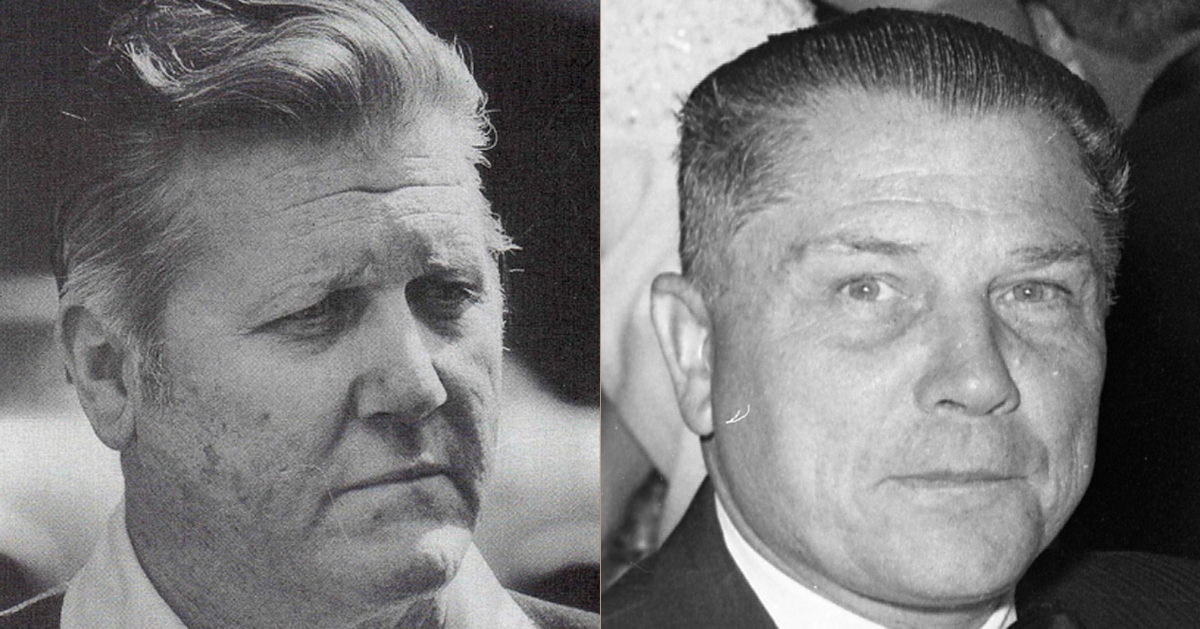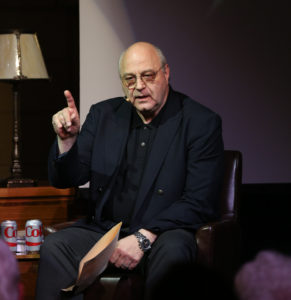
New movie rekindles debate over Jimmy Hoffa killing
Martin Scorsese’s The Irishman has Mafia experts at odds

Martin Scorsese’s upcoming movie The Irishman is reviving a dispute over who killed former national labor leader Jimmy Hoffa.
The current disagreement over the 62-year-old Hoffa’s death in 1975 centers on two East Coast hit men, Frank “The Irishman” Sheeran and Salvatore “Sally Bugs” Briguglio. Both are now dead.
That dispute is revving up as the Netflix movie’s expected fall release date approaches. A trailer for the film aired during the Academy Awards telecast in February, igniting interest among fans eager to see Scorsese’s latest Mob project. The veteran filmmaker also directed Mob classics such as Goodfellas, Casino and The Departed.
Interest in Hoffa’s whereabouts has been part of the national conversation for nearly 44 years. At one time, an urban legend that became a running joke had it that he was buried at now-demolished Giants Stadium in New Jersey.
A former president of the International Brotherhood of Teamsters, Hoffa disappeared on July 30, 1975, from the parking lot of a suburban Detroit restaurant, the Machus Red Fox, where he supposedly was to meet with Mafia leaders, including New Jersey’s Anthony “Tony Pro” Provenzano.
Despite multiple false leads, his body has never been recovered, and no one has been held criminally responsible in the disappearance. Seven years after the scheduled sit-down with mobsters at that restaurant in Bloomfield Hills, Michigan, Hoffa was declared legally dead.
As for Scorsese’s The Irishman, even before the movie has been shown to the public its depiction of the truth is being debated in ways that aren’t an issue with pure works of fiction such as Mario Puzo’s The Godfather.
The Scorsese film, featuring Robert De Niro as the World War II combat soldier and Mafia hit man Sheeran, is based on the 2004 book I Heard You Paint Houses by Charles Brandt, a former homicide prosecutor and Delaware deputy attorney general. The book resulted from Brandt’s numerous interviews with Sheeran in which the longtime assassin, who is reported to have killed as many as 30 people, claims to have shot his friend Hoffa twice in the back of the head in a Detroit residence on orders from Mafia leaders. “Painting houses” is Mafia jargon for a contract killing.
In 2003, Sheeran died of cancer at age 83.
Among those who have explored the Sheeran angle in depth are Eric Shawn, a Fox News anchor and senior correspondent, and former Fox producer Ed Barnes. Shawn is the host of a recent two-hour program, Riddle: The Search for James R. Hoffa, on the Fox Nation streaming subscription service, the title being a play on Hoffa’s middle name, Riddle.
In 2004, Shawn and Barnes discovered blood drops inside a house near the Machus Red Fox where Sheeran said the shooting took place. Though Hoffa’s DNA did not match the recovered drops, Shawn has said he would like for the samples to be retested, using today’s technology.
“The blood pattern fits his story exactly,” Shawn said in a telephone interview, recounting Sheeran’s version of events.

Shawn also is calling for the federal government to release all unredacted FBI files on the Hoffa case. He and others have noted that most of the people supposedly involved in the incident either are dead or have already been named publicly. Of those who might have had a role in the disappearance, Hoffa’s “foster son,” Chuckie O’Brien, is still alive, residing, according to Shawn, in a gated community in Florida. Another person suspected of being somehow involved, Thomas Andretta, died in Las Vegas in January.
“It’s time for the government to come clean,” Shawn said in the interview. “Let’s let it all out.”
In addition to the broadcast special, Shawn hosts an eight-part companion podcast, exploring different angles in the Hoffa disappearance. Among those whom Shawn interviews in the broadcast special and podcast is investigative journalist Dan E. Moldea, author of the 1978 book The Hoffa Wars: Teamsters, Rebels, Politicians and the Mob.
Moldea has praised Shawn and Barnes for their work on the Hoffa mystery over the years, and for keeping it in the public eye, but disagrees on who the killer was.
Contending that Sheeran changed his story over time, Moldea says his research and sources indicate the shooter was Briguglio, a Mob-connected New Jersey Teamsters business agent. Briguglio, who denied during a 1976 interview with Moldea that he had a role, did not live many years after the Hoffa disappearance. In 1978, two unknown assassins shot Briguglio to death on Mulberry Street in New York City’s Little Italy.
In a recent email, Moldea said the upcoming Scorsese movie will be, like Oliver Stone’s JFK, “good cinema, bad history.”
“I believe that the film fantasy The Irishman is the result of an initial con job, perpetrated by a labor racketeer, Frank Sheeran, which led to a heavily fictionalized one-source book that then metastasized into a major motion picture project on which Netflix is now betting somewhere between $140 and $175 million (or even more) that Sheeran told the truth,” Moldea said in the email, “when, in fact, there is an enormous amount of evidence that he didn’t.”
Another topic of contention in the Hoffa disappearance is the motive behind the killing. One reported motive is that Mafia bosses didn’t want him taking over the national Teamsters again after his prison term on jury tampering and pension fraud convictions, fearing the revenge-minded Hoffa would expose the union’s Mob connections.
A different motive, which Barnes discusses in a podcast with Shawn, is that “Tony Pro” Provenzano, a Genovese crime family captain in New Jersey, was upset with Hoffa for not supporting an East Coast Mafia plan to build a casino on the Las Vegas Strip. Hoffa had backed other underworld figures wanting access to the Teamsters’ Central States Pension Fund for casino construction.
Barnes reported on the casino proposal in 1978 as an investigative reporter at the Morning News in Paterson, New Jersey.
This Las Vegas casino would have been built on 14 acres between the Dunes hotel-casino and the Jockey Club, but the project never materialized. These days, with the Dunes having been demolished in the 1990s, the expansive Bellagio occupies much of that space. The newer Cosmopolitan hotel-casino now towers over the Jockey Club.

The identity of the killer and the motive are not the only remaining controversies regarding The Irishman. Director Steven Spielberg has argued that movies on the Netflix streaming service, even after exposure in a theatrical run as is expected with The Irishman, should not be considered for an Oscar.
According to Variety magazine, Spielberg said in an interview with ITV, “Once you commit to a television format, you’re a TV movie. You certainly, if it’s a good show, deserve an Emmy, but not an Oscar. I don’t believe films that are just given token qualifications in a couple of theaters for less than a week should qualify for the Academy Award nomination.”
Recent news stories, however, indicate that the Jaws and Schindler’s List director has met with a Netflix executive potentially to resolve disputes.
Finally, there is yet another remaining mystery in the Hoffa saga, this one involving the disposal of his body. Some contend Hoffa was cremated in Detroit, but others, including Moldea and Barnes, believe the body was transported 600 miles east of Detroit to New Jersey.
Moldea has written that Hoffa was buried in a landfill near the Hackensack River in Jersey City. Barnes says Hoffa’s remains were shredded at a New Jersey chicken farm associated with Briguglio and then dumped in the ocean miles from shore, meaning Hoffa’s body won’t ever be recovered.
During a recent telephone interview, Barnes said of the body, “They’re never going to find one.”
Larry Henry is a veteran print and broadcast journalist. He served as press secretary for Nevada Governor Bob Miller, and was political editor at the Las Vegas Sun and managing editor at KFSM-TV, the CBS affiliate in Northwest Arkansas. Henry taught journalism at Haas Hall Academy in Bentonville, Arkansas, and now is the headmaster at the school’s campus in Rogers, Arkansas. The Mob in Pop Culture blog appears monthly.
Feedback or questions? Email blog@themobmuseum.org





